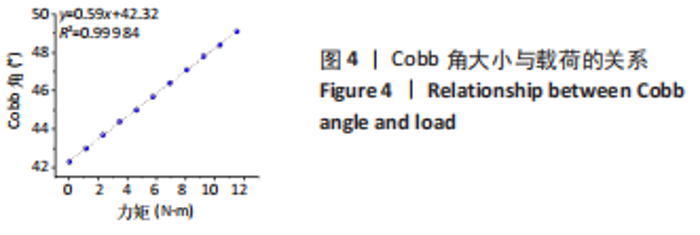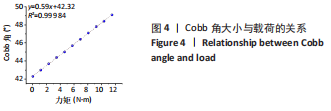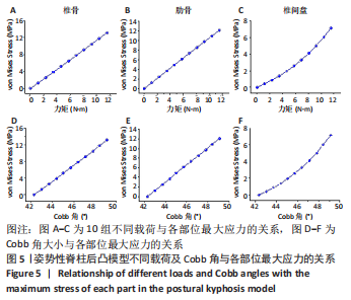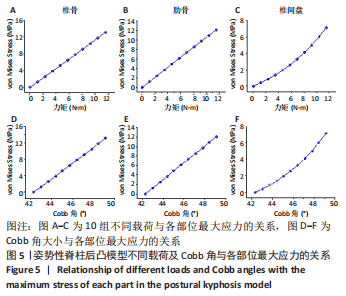Chinese Journal of Tissue Engineering Research ›› 2024, Vol. 28 ›› Issue (24): 3773-3777.doi: 10.12307/2024.605
Biomechanical response of postural kyphosis under the action of bending moments
Wang Lei, Wang Chenyan, Guo Yuan, Li Xiaona, Chen Weiyi
- College of Biomedical Engineering, Taiyuan University of Technology, Taiyuan 030024, Shanxi Province, China
-
Received:2023-06-10Accepted:2023-07-15Online:2024-08-28Published:2023-11-20 -
Contact:Chen Weiyi, PhD, Professor, College of Biomedical Engineering, Taiyuan University of Technology, Taiyuan 030024, Shanxi Province, China -
About author:Wang Lei, Master candidate, College of Biomedical Engineering, Taiyuan University of Technology, Taiyuan 030024, Shanxi Province, China -
Supported by:National Natural Science Foundation of China, No. 11632013 (to CWY)
CLC Number:
Cite this article
Wang Lei, Wang Chenyan, Guo Yuan, Li Xiaona, Chen Weiyi. Biomechanical response of postural kyphosis under the action of bending moments[J]. Chinese Journal of Tissue Engineering Research, 2024, 28(24): 3773-3777.
share this article
Add to citation manager EndNote|Reference Manager|ProCite|BibTeX|RefWorks
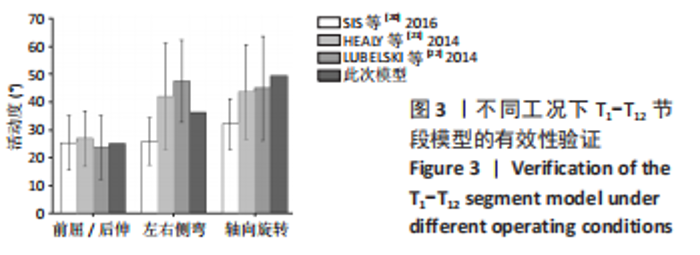
2.1 模型验证 由于针对全部节段脊柱的生物力学研究相关文献较少,因而此文选择T1-T12节段进行模型验证。采用与SIS等[20]、HEALY等[21]、LUBELSKI等[22]体外生物力学实验相同的工况进行模型验证,将T12椎骨下端完全固定,在T1椎骨上表面施加5 N·m力矩模拟前屈、后伸、左右侧弯、左右旋转6种工况,记录T1-T12节段脊柱从起始端至终末端的运动范围,定义为活动度,单位为°。将结果与SIS等[20]、HEALY等[21]、LUBELSKI等[22]的体外生物力学实验数据对比,验证模型的有效性(图3)。结果表明,此文所建的有限元模型在前屈、后伸、侧弯、旋转6种工况下的活动度均与尸体实验数据相接近,说明此模型具有一定的有效性,可以用于后续研究。"
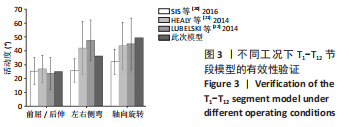
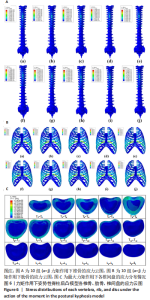
随着Cobb角逐渐增大,胸椎与肋骨上最大von Mises应力呈线性增长趋势,Cobb角每增大1°,胸椎和肋骨上的最大应力分别增大1.93 MPa和1.78 MPa。随着Cobb角逐渐增大,椎间盘上最大von Mises应力表现为非线性,呈现出加速增长趋势,见图5。 2.4 椎骨、肋骨和椎间盘应力分布情况 在10组力矩作用下椎骨、肋骨的最大应力云图如图6A、B所示,椎骨和肋骨的最大应力分别出现在T6椎骨的前侧、第10对肋骨的肋头处;最大力矩作用下各椎间盘应力云图如图6C所示,姿势性脊柱后凸过程中椎间盘应力大多分布在胸段椎间盘纤维环前侧和后侧。其中T5-T6、T6-T7节段椎间盘应力较大,应力集中在椎间盘的前侧和后侧左右两边。"
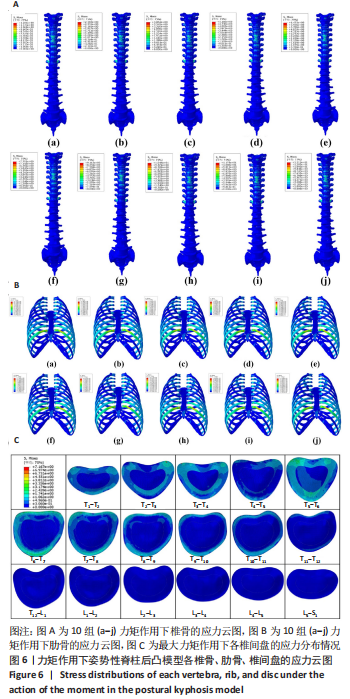
| [1] FON GT, PITT MJ, THIES JR AC. Thoracic kyphosis: range in normal subjects. American J Roentgenol. 1980;134(5):979-983. [2] CANAVESE F, ŞENKÖYLÜ A. Postural Kyphosis//Essentials of Spine Surgery. Springer, Cham, 2022: 131-134. [3] YAMAN O, DALBAYRAK S. Kyphosis and review of the literature. Turk Neurosurg. 2014;24(4): 455-465. [4] KESHAVARZI F, AZADINIA F, TALEBIAN S, et al. Impairments in trunk muscles performance and proprioception in older adults with hyperkyphosis. J Man Manip Ther. 2022;30(4):249-257. [5] BRIGGS AM, VAN DIEËN JH, WRIGLEY TV, et al. Thoracic kyphosis affects spinal loads and trunk muscle force. Phys Ther. 2007;87(5):595-607. [6] FENG Q, WANG M, ZHANG Y, et al. The effect of a corrective functional exercise program on postural thoracic kyphosis in teenagers: a randomized controlled trial. Clin Rehabil. 2018;32(1):48-56. [7] KAMALI F, SHIRAZI S A, EBRAHIMI S, et al. Comparison of manual therapy and exercise therapy for postural hyperkyphosis: a randomized clinical trial. Physiother Theory Pract. 2016;32(2):92-97. [8] SZCZYGIEŁ E, WĘGLARZ K, PIOTROWSKI K, et al. Biomechanical influences on head posture and the respiratory movements of the chest. Acta Bioeng Biomech. 2015;17(2):143-148. [9] HARRISON DE, CAILLIET R, HARRISON DD, et al. How do anterior/posterior translations of the thoracic cage affect the sagittal lumbar spine, pelvic tilt, and thoracic kyphosis? Eur Spine J. 2002;11:287-293. [10] 任航宁,居来提·买提肉孜,帕尔哈提·热西提,等.皮质骨轨迹椎弓根系统拔出力下腰椎的有限元分析[J].中国组织工程研究,2021,25(36):5771-5776. [11] 李健,关天民,朱晔.有限元法分析骶椎腰化的力学特征[J].中国组织工程研究,2022, 26(33):5249-5253. [12] LEE N, JI GY, YI S, et al. Finite element analysis of the effect of epidural adhesions. Pain Physician. 2016;19(5):787-793. [13] SCHMIDT H, HEUER F, SIMON U, et al. Application of a new calibration method for a three-dimensional finite element model of a human lumbar annulus fibrosus. Clin Biomech (Bristol, Avon). 2006;21(4):337-344. [14] 李超. 胸段脊柱非线性三维有限元建模及近端交界性后凸问题研究[D].上海:第二军医大学,2015. [15] 肖智韬. 基于非线性有限元法的人体腰椎强度预测及其在腰椎相关疾病中的应用[D].长春:吉林大学,2013. [16] 聂文忠. 脊柱胸腰部的生物力学建模与应用研究[D].上海:上海交通大学,2009. [17] 贾少薇,张顺心,范顺成,等.脊柱侧凸腰骶椎结构的有限元分析及其变形趋势[J].医用生物力学,2017,32(3):235-241. [18] POLIKEIT A, NOLTE LP, FERGUSON SJ. The effect of cement augmentation on the load transfer in an osteoporotic functional spinal unit: finite-element analysis. Spine (Phila Pa 1976). 2003; 28(10):991-996. [19] SYLVESTRE PL, VILLEMURE I, AUBIN CE. Finite element modeling of the growth plate in a detailed spine model. Med Biol Eng Comput. 2007;45(10):977-988. [20] SIS HL, MANNEN EM, WONG BM, et al. Effect of follower load on motion and stiffness of the human thoracic spine with intact rib cage. J Biomech. 2016;49(14):3252-3259. [21] HEALY AT, LUBELSKI D, MAGESWARAN P, et al. Biomechanical analysis of the upper thoracic spine after decompressive procedures. Spine J. 2014;14(6):1010-1016. [22] LUBELSKI D, HEALY AT, MAGESWARAN P, et al. Biomechanics of the lower thoracic spine after decompression and fusion: a cadaveric analysis. Spine J. 2014;14(9):2216-2223. [23] KIEFER A, SHIRAZI-ADL A, PARNIANPOUR M. Synergy of the human spine in neutral postures. Eur Spine J. 1998;7:471-479. [24] MATSUMOTO K, SHAH A, KELKAR A, et al. Sagittal Imbalance May Lead to Higher Risks of Vertebral Compression Fractures and Disc Degeneration—A Finite Element Analysis. World Neurosurg. 2022;167:e962-e971. [25] SFEROPOULOS N K. Stable Compression Fractures of the Thoracic Spine in Children: The Value of Secondary Radiographic Signs. EC Orthop. 2022;13:59-70. [26] WAHLE CF, HART CM, BECK JJ. First Rib Stress Fracture in an Adolescent Elite Tennis Player: A Case Report. JBJS Case Connect. 2023;13(1):e22. [27] ZHENG L, CAO Y, YANG Y, et al. Biomechanical response of lumbar intervertebral disc in daily sitting postures: a poroelastic finite element analysis. Comput Methods Biomech Biomed Engin. 2022:1-10. [28] ZHAO G, WANG H, WANG L, et al. The Biomechanical Effects of Different Bag‐Carrying Styles on Lumbar Spine and Paraspinal Muscles: A Combined Musculoskeletal and Finite Element Study. Orthop Surg. 2023;15(1):315-327. [29] WILKE HJ, NEEF P, HINZ B, et al. Intradiscal pressure together with anthropometric data–a data set for the validation of models. Clin Biomech (Bristol, Avon). 2001;16:S111-S126. [30] JEONG JG, KANG S, JUNG GH, et al. Biomechanical Effect of Disc Height on the Components of the Lumbar Column at the Same Axial Load: A Finite-Element Study. J Healthc Eng. 2022;2022:1-13 [31] ANDERSON DE, MANNEN EM, SIS HL, et al. Effects of follower load and rib cage on intervertebral disc pressure and sagittal plane curvature in static tests of cadaveric thoracic spines. J Biomech. 2016;49(7):1078-1084. [32] DESMOULIN GT, PRADHAN V, MILNER TE. Mechanical aspects of intervertebral disc injury and implications on biomechanics. Spine (Phila Pa 1976). 2020;45(8):E457-E464. [33] 胡哲,王星,和雨洁,等.肋头关节骨性关节面的形态特征及其临床意义[J].中国临床解剖学杂志,2022,40(2):132-137. |
| [1] | Li Zhifei, Yang Yin, Chen Hualong, Liang Qinqiu, Zhong Yuanming, Zhang Yisheng. Finite element analysis of the correlation between tilt angle of titanium cage and postoperative subsidence of titanium cage after anterior subtotal cervical corpectomy, decompression and fusion [J]. Chinese Journal of Tissue Engineering Research, 2024, 28(9): 1313-1319. |
| [2] | Chen Mengmeng, Bao Li, Chen Hao, Jia Pu, Feng Fei, Shi Guan, Tang Hai. Biomechanical characteristics of a novel interspinous distraction fusion device BacFuse for the repair of lumbar degenerative disease [J]. Chinese Journal of Tissue Engineering Research, 2024, 28(9): 1325-1329. |
| [3] | Liang Cheng, Zhang Linqi, Wang Guan, Li Wen, Duan Ke, Li Zhong, Lu Xiaobo, Zhuo Naiqiang. Finite element and biomechanical analysis of different implants in repair for unilateral unstable pelvic posterior ring injury [J]. Chinese Journal of Tissue Engineering Research, 2024, 28(9): 1336-1341. |
| [4] | Yang Junliang, Lu Tan, Xu Biao, Jiang Yaqiong, Wang Fucheng. Three-dimensional finite element analysis of effects of partial anterior cruciate ligament rupture on knee joint stress [J]. Chinese Journal of Tissue Engineering Research, 2024, 28(9): 1347-1353. |
| [5] | Weng Rui, Lin Dongxin, Guo Haiwei, Zhang Wensheng, Song Yuke, Lin Hongheng, Li Wenchao, Ye Linqiang. Abnormal types of intervertebral disc structure and related mechanical loading with biomechanical factors [J]. Chinese Journal of Tissue Engineering Research, 2024, 28(9): 1436-1442. |
| [6] | Xiaheida·Yilaerjiang, Nijiati·Tuerxun, Reyila·Kuerban, Baibujiafu·Yelisi, Chen Xin. Three-dimensional finite element analysis of the distribution pattern of stress in bone tissues with different characteristics [J]. Chinese Journal of Tissue Engineering Research, 2024, 28(8): 1277-1282. |
| [7] | Zuo Xinwei, Liu Gang, Bai Huizhong, Xu Lin, Zhao Yi, Ren Jingpei, Hu Chuanyu, Mu Xiaohong. Relationship between lumbar spine development and hip development in children with spastic cerebral palsy [J]. Chinese Journal of Tissue Engineering Research, 2024, 28(8): 1247-1252. |
| [8] | Wang Qiang, Li Shiyun, Xiong Ying, Li Tiantian. Biomechanical changes of the cervical spine in internal fixation with different anterior cervical interbody fusion systems [J]. Chinese Journal of Tissue Engineering Research, 2024, 28(6): 821-826. |
| [9] | Wei Yuanbiao, Lin Zhan, Chen Yanmei, Yang Tenghui, Zhao Xiao, Chen Yangsheng, Zhou Yanhui, Yang Minchao, Huang Feiqi. Finite element analysis of effects of sagittal cervical manipulation on intervertebral disc and facet joints [J]. Chinese Journal of Tissue Engineering Research, 2024, 28(6): 827-832. |
| [10] | Zhang Rui, Wang Kun, Shen Zicong, Mao Lu, Wu Xiaotao. Effects of endoscopic foraminoplasty and laminoplasty on biomechanical properties of intervertebral disc and isthmus [J]. Chinese Journal of Tissue Engineering Research, 2024, 28(6): 833-839. |
| [11] | Kang Zhijie, Cao Zhenhua, Xu Yangyang, Zhang Yunfeng, Jin Feng, Su Baoke, Wang Lidong, Tong Ling, Liu Qinghua, Fang Yuan, Sha Lirong, Liang Liang, Li Mengmeng, Du Yifei, Lin Lin, Wang Haiyan, Li Xiaohe, Li Zhijun. Finite element model establishment and stress analysis of lumbar-sacral intervertebral disc in ankylosing spondylitis [J]. Chinese Journal of Tissue Engineering Research, 2024, 28(6): 840-846. |
| [12] | Zhang Min, Peng Jing, Zhang Qiang, Chen Dewang. Mechanical properties of L3/4 laminar decompression and intervertebral fusion in elderly osteoporosis patients analyzed by finite element method [J]. Chinese Journal of Tissue Engineering Research, 2024, 28(6): 847-851. |
| [13] | Wu Maodong, Su Qinglun, Huang Yiming, Shen Longying, Lu Yu, Zhao Qin. Correlation between coronal pressure variation and coronal imbalance in adolescent idiopathic scoliosis patients [J]. Chinese Journal of Tissue Engineering Research, 2024, 28(6): 852-856. |
| [14] | Xue Xiaofeng, Wei Yongkang, Qiao Xiaohong, Du Yuyong, Niu Jianjun, Ren Lixin, Yang Huifeng, Zhang Zhimin, Guo Yuan, Chen Weiyi. Finite element analysis of osteoporosis in proximal femur after cannulated screw fixation for femoral neck fracture [J]. Chinese Journal of Tissue Engineering Research, 2024, 28(6): 862-867. |
| [15] | Huang Peizhen, Dong Hang, Cai Qunbin, Lin Ziling, Huang Feng. Finite element analysis of anterograde and retrograde intramedullary nail for different areas of femoral shaft fractures [J]. Chinese Journal of Tissue Engineering Research, 2024, 28(6): 868-872. |
| Viewed | ||||||
|
Full text |
|
|||||
|
Abstract |
|
|||||
